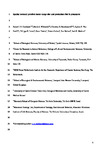Spatial memory predicts home range size and predation risk in pheasants
| dc.contributor.author | Heathcote, RJP | |
| dc.contributor.author | Whiteside, Mark | |
| dc.contributor.author | Beardsworth, CE | |
| dc.contributor.author | Van Horik, JO | |
| dc.contributor.author | Laker, PR | |
| dc.contributor.author | Toledo, S | |
| dc.contributor.author | Orchan, Y | |
| dc.contributor.author | Nathan, R | |
| dc.contributor.author | Madden, JR | |
| dc.date.accessioned | 2023-02-16T13:40:29Z | |
| dc.date.issued | 2023-01-23 | |
| dc.identifier.issn | 2397-334X | |
| dc.identifier.issn | 2397-334X | |
| dc.identifier.uri | http://hdl.handle.net/10026.1/20410 | |
| dc.description.abstract |
Most animals confine their activities to a discrete home range, long assumed to reflect the fitness benefits of obtaining spatial knowledge about the landscape. However, few empirical studies have linked spatial memory to home range development or determined how selection operates on spatial memory via the latter's role in mediating space use. We assayed the cognitive ability of juvenile pheasants (Phasianus colchicus) reared under identical conditions before releasing them into the wild. Then, we used high-throughput tracking to record their movements as they developed their home ranges, and determined the location, timing and cause of mortality events. Individuals with greater spatial reference memory developed larger home ranges. Mortality risk from predators was highest at the periphery of an individual's home range in areas where they had less experience and opportunity to obtain spatial information. Predation risk was lower in individuals with greater spatial memory and larger core home ranges, suggesting selection may operate on spatial memory by increasing the ability to learn about predation risk across the landscape. Our results reveal that spatial memory, determined from abstract cognitive assays, shapes home range development and variation, and suggests predation risk selects for spatial memory via experience-dependent spatial variation in mortality. | |
| dc.format.extent | 461-471 | |
| dc.format.medium | Print-Electronic | |
| dc.language | en | |
| dc.language.iso | eng | |
| dc.publisher | Nature Research | |
| dc.subject | Animals | |
| dc.subject | Homing Behavior | |
| dc.subject | Spatial Memory | |
| dc.subject | Predatory Behavior | |
| dc.subject | Galliformes | |
| dc.title | Spatial memory predicts home range size and predation risk in pheasants | |
| dc.type | journal-article | |
| dc.type | Journal Article | |
| dc.type | Research Support, Non-U.S. Gov't | |
| plymouth.author-url | https://www.webofscience.com/api/gateway?GWVersion=2&SrcApp=PARTNER_APP&SrcAuth=LinksAMR&KeyUT=WOS:000919729800002&DestLinkType=FullRecord&DestApp=ALL_WOS&UsrCustomerID=11bb513d99f797142bcfeffcc58ea008 | |
| plymouth.issue | 3 | |
| plymouth.volume | 7 | |
| plymouth.publication-status | Published online | |
| plymouth.journal | Nature Ecology and Evolution | |
| dc.identifier.doi | 10.1038/s41559-022-01950-5 | |
| plymouth.organisational-group | /Plymouth | |
| plymouth.organisational-group | /Plymouth/Faculty of Science and Engineering | |
| plymouth.organisational-group | /Plymouth/Faculty of Science and Engineering/School of Biological and Marine Sciences | |
| plymouth.organisational-group | /Plymouth/Users by role | |
| plymouth.organisational-group | /Plymouth/Users by role/Academics | |
| dc.publisher.place | England | |
| dcterms.dateAccepted | 2022-11-09 | |
| dc.rights.embargodate | 2023-7-23 | |
| dc.identifier.eissn | 2397-334X | |
| dc.rights.embargoperiod | Not known | |
| rioxxterms.versionofrecord | 10.1038/s41559-022-01950-5 | |
| rioxxterms.licenseref.uri | http://www.rioxx.net/licenses/all-rights-reserved | |
| rioxxterms.licenseref.startdate | 2023-01-23 | |
| rioxxterms.type | Journal Article/Review |


